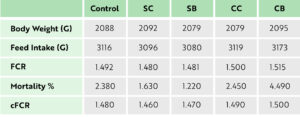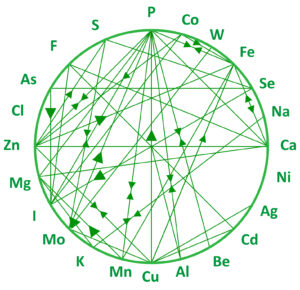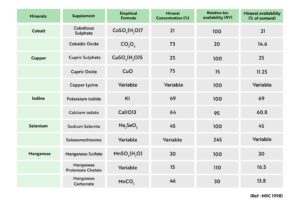Trace minerals are indispensable components in poultry diets. Minerals like Calcium, Phosphorus, and Manganese play a major role in growth, bone development of birds, whereas Copper and Zinc are responsible for maintaining the feather color. Minerals have a key role in enzyme structure like Catalase(Fe), carbonic anhydrous(Zn), SOD(Cu,Zn,Mn) and GSH(Se). There are two forms of trace elements available to birds ie., Inorganic and Organic form. Trace minerals in inorganic forms such as oxides, chlorides, carbonates and sulfates salts are used for a long time in poultry diets.
In commercial practice, inorganic trace minerals (ITM) are used to supplement 2–10 times than the amounts recommended by the National Research Council for poultry diets(Esenbuga et al., 2008). However, the bioavailability of inorganic minerals is significantly low as a considerable amount is lost and excreted through the feces due to antagonistic effects with substances present in the poultry diet. High inclusion level will leads to the mineral wastage and environmental pollution due to excessive excretion by the birds (Leeson, 2003) For example, 94% of total ingested zinc is added to the environment by excretion which may lead to phytotoxicity of soil( Zafar et al., 2018), Excess excretion of Phosphorus may lead to eutrophication
Normal antagonist effects seen are listed below with other minerals, vitamins and other ANF
- Hempe & Cousins(1989 )stated that phytates reduce zinc uptake and impair the absorption of copper and zinc (Lowel et al., 1994).
- Copper and molybdenum are strongly antagonist, However manganese and iron compete for similar absorption mechanisms (Sandstrom, 1992).
- Chemical reaction between sodium selenite and ascorbic acid (AA) in premix, feed, or gut may cause reduction of selenite to elemental Se, which cannot be absorbed in the GIT of chickens, and the oxidation of Vitamin C, which thereby loses its biological activity (Gosetti et al., 2007)
- It’s been shown that selenite is dissolved once distributed in feeds with relatively high water activity(Aw). When dissolved, it might form selenious acid and disperse as a vapor (Eisenberg et al., 2007)
Ionized metals will be normally transported through the cell membrane using protein carriers. This process is pH-dependent, and so, the acidic pH within the proventriculus improves solubilization, whereas the neutral or basic pH of the small intestine reduces the rate of absorption. Solubilized metals within the gastric environment will probably form insoluble precipitates in their course through the small and large intestine. The presence of active ligands, like phytic acid, will intensify the formation of precipitates. This situation is significant in high phytate diets, such as those with high levels of soybean meal or rice bran, and can strongly impact mineral availability. Phytate content is very variable in soybeans and can reach upto 3% in soybean meals (Mason et al., 1992)
Competition for the same or similar carriers may interfere during transportation from the lumen into the enterocyte. The competition between iron and copper is normal; they share at least two membrane proteins like transferrin and metallothionein (Hill & Matrone, 1970). Carriers are small proteins, which can withstand high capacity of chelating free cations existing in the intestinal solution when proceeding to transport. Excessive copper may bind to those protein which may cause iron deficiency (El Shobaki & Rummer, 1979)
Bioavailability of Minerals:
The sources of minerals not only depend on their mineral content, but also on the proportion of minerals that can be utilized by the animal, which is termed as ‘bioavailability’ (Ammerman et al., 1995).
Bioavailability has four components as follow:
Accessibility – the accessibility of the mineral to the absorptive mucosa.
Absorbability – the possible transfer of absorbable minerals across the mucosa.
Retainability – the potential retention of the transferred mineral &
Functionality – the potential for assimilation of retained mineral into functional forms.(Suttle et al., 2010)
It is found that organic chelated minerals have higher bioavailability over inorganic salts of metals.
Organic Minerals:
Organic microelements have been principally defined by AAFCO (2000). The word chelate is derived from the Greek word “chele”, which means tweezers or claw. The reasons for this definition become clear when we see the structure of chelates. They are the result of electron sharing between a metal and a ligand. A ligand is typically an anion or a molecule, which takes an atom or a pair of electrons with available valances. Common ligands comprise oxygen, nitrogen, sulfur, halogens, or a combination of these due to their electronic structure
Chelated minerals have non-metallic ligands, and as a result its term is organic. Atoms, which are able to donate their electrons, are termed as donor atoms. Ligands with only 1 donor atom are referred to as monodentate, whereas those with 2 or additional are referred to as polydents. Solely polydents are able to form chelates, since they will bind a metal among their electronic dents or claws to form a coordinate bond.
Specific Metal Amino Acid Chelate is result of combination a soluble mineral salt with a specific amino acid resulting from complexing a soluble metal salt with amino acids ie., 1 mol of the metal salts will be combined with to 1 – 3 (preferably 2) moles of amino acids, which form coordinate bonds (molecular weight of the hydrolyzed chelate should exceed 800 Daltons) (Vieira et al., 2008)
Proteinate Complex/Chelate is the result of chelation of a soluble salt with hydrolysed protein .
Polysaccharide Metal Chelate, resulting from complexing a soluble mineral salt with a solution of polysaccharides which may be integral part of an specific complex
Chelation with methionine analogue like HMTBA which is not an amino acid (AA) but relatively an organic acid contains a hydroxyl group on the α carbon instead of the amino group found in Methionine. Its mineral binding is also alike to that of Methionine except that the hydroxyl group substitutes the amino group in the formation of the mineral complex (Dibner et al., 2004)
Yeast chelate: Minerals are added to solid phase fermenter and allowed to get absorbed but this phase is depend on following parameter like yeast strain, source of inorganic metal, Metal concentration, base medium, energy sources (like corn ,DDGC,molasses etc.,), pH, temperature, shaking speed, incubation time , inoculum size, and aeration. (Esmaeili and Khosravi-Darani, 2014)
Mode of action:
After mineral intake in chelate form, absorption will happen in any part of the small intestine whereas inorganic metals are typically absorbed in duodenum. After reaching to intestinal lumen when hydrolysis in gastric region where ligand atoms covalently bonded with metal atoms work as transporter and also protect the mineral atom from numerous antagonists in their manner like oxalic acid, gossypol, phytates etc. After that, these complexes get absorbed by enterocytes in the intestine whereas inorganic forms solely absorbed wherever they get transporter within the type of inorganic metal. Otherwise, they might be excreted (Swiatkiewicz et al., 2014).
Hudson et al. (2004) stated that supplementation of zinc in organic and inorganic form like -amino acid chelate and sulfate form , showed improvement of eggshell in amino acid chelate group that led to the production of 3.6 extra chicks at the end of the laying period.
Van Beirendonck et al., (2016) reported that Se content in the muscles of broilers fed a diet supplemented with sodium selenite was 133 μg/kg, whereas the broilers fed a diet supplemented with Se-yeast containing 26% or 69% SeMet was 161 and 267 μg/kg Se.
Khatun et al.(2019) reported that Proteinate minerals groups showed higher profitability in terms of overall performance followed by propionate fed broilers group.
Recent field study was conducted to check the impact between inorganic minerals and organic minerals(Complemin® 7+ & competitor product) in Cobb broilers for 5 weeks and grouping of the trial was as follows:
Control group: ITM @ 1 kg / ton
SC group: ITM @ 1 kg / ton + Complemin 7 + @ 500 g / ton
Group SB: ITM @ 1 kg / ton + competitor’s OTM @ 500 g / ton
CC: Complemin 7 + @ 500 g / ton
CB: Competitor’s TM @ 500 g / ton
Results:
1.Supplementation with chelated minerals improves bird performance when the birds register fast growth. The effect of chelated minerals was not apparent until the last week when the birds registered their highest weight gain. Given the facts that mineral reserves accumulate over time and higher mineral levels are needed when the birds register high growth rates, chelated minerals should be provided as supplements from the prestarter stage. This study shows that such a strategy is also cost effective.
2. Complete replacement of inorganic trace minerals with chelated trace minerals at 50% dosage results in some performance loss, especially survival loss. Claims that chelated trace minerals have very high bioavailability that inorganic trace minerals can be replaced by chelated trace minerals at 20% or lower (Leeson 2005) should, therefore, be viewed with caution.
3. Among the two chelated minerals,Bentoli’s Complemin® 7+ performed as well as or better than the more expensive competitor product in most respects of production, except for meat yield.

Reference:
Ammerman, C.B., Baker, D.P. and Lewis, A.J. eds., 1995. Bioavailability of nutrients for animals: Amino acids, minerals, vitamins. Elsevier.
Dibner, J. J., M. Trehy, C. S. Schasteen, and J. A. Hume. 2004. Use of 2-hydroxy-4-(methylthio)butanoic acid (HMTBA) as a ligand for organic trace minerals. Poult. Sci. 83(Suppl. 1):832. (Abstr.)
El-Shobaki F, Rummer W. Binding of copper to mucosal transferring and inhibition of intestinal iron absorption in rats. Research in Experimental Medicine 1979; 174:187-195
Esenbuga N, Macit M, Karaoglu M, Aksu MI, Bilgin OC. Effects of dietary hamate supplementation to broilers on performance, slaughter, carcass and meat color. J Sci Food Agric 2008; 88(7):1201–7;
Esmaeili S and Khosravi-Darani K. Selenium-Enriched Yeast: As Selenium Source for Nutritional Purpose. Current Nutrition & Food Science, 10: 49-56. 2014
Gosetti F, P. Frascarolo P, Polati S, Medana C, Gianotti V, Palma P, Aigotti R, Baiocchi C and Gennaro MC. Speciation of selenium in diet supplements by HPLC–MS/MS methods. Food Chemistry, 105: 1738–1747. 2007
Hempe JM, Cousins RJ.Effect of EDTA and Zinc-methionine complex on zinc absorption by rat intestine. Journal of Nutrition 1989; 119:1179-1187.
Hill CH, Matrone G. Chemical parameters in the study of in vivo and in vitro interactions of transition elements. Federation Proceedings 1970; 29:1474-81.
Hudson BP, Dozier WA, Wilson JL. Sander JE, Ward TL. Reproductive performance and immune status of caged broiler breeder hens provided diets supplemented with either inorganic or organic sources of zinc from hatching to 65 wk of age. Journal of Applied Poultry Research 2004; 13:349-359.
Leeson, S., 2003. A new look at the trace mineral nutrition of poultry: Can we reduced environmental burden of poultry manure? Nutritional biotechnology in the feed and food industries
Leeson, S. 2005 Trace mineral requirements of poultry: validity of the NRC recommendations. In: Re-defining Mineral Nutrition (Ed: JA Taylor-Pickard & LA Tucker), Nottingham University Press, p. 107 117.
Lowel JA, Wiseman J, Cole DJA. Absorption and retention of zinc when] administered as an amino-acid chelate in the dog. Journal of Nutrition 1994; 124:2572-2574.
Suttle, N.F., 2010. Mineral nutrition of livestock. Cabi.
Sandstrom B. Dose dependence of zinc and magnesium absorption in man. Proceedings of the Nutrition Society 1992; 51:211-218.
Swiatkiewicz, S., Arczewska-Włosek, A., Jozefiak, D., 2014. The efficacy of organic minerals in poultry nutrition: review and implications of recent studies. World’s Poultry Sci. J., 70(3): 475-486
Vieira, S.L., 2008. Chelated minerals for poultry. Brazilian Journal of Poultry Science, 10(2), pp.73-79.



